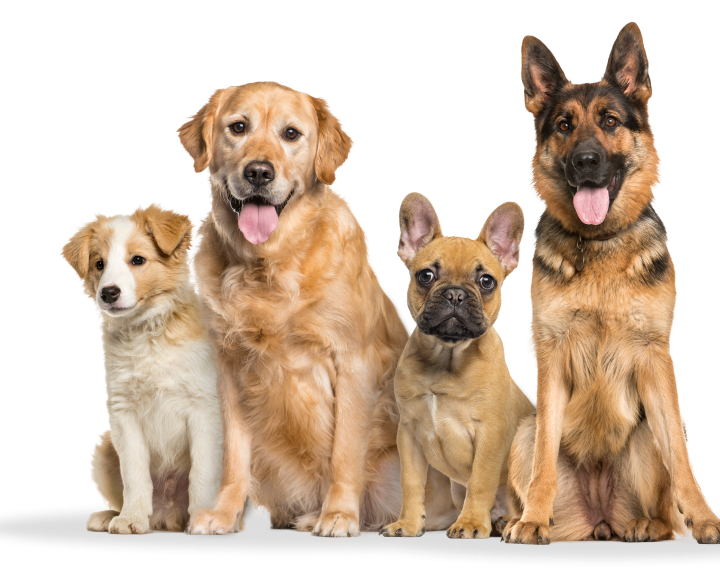What is Nasal Cancer?
Nasal cancer in dogs is more commonly found in older canines. It is also more likely to occur in medium to large dogs with long noses (Greyhound, German Shepherd, and Husky). Researchers are uncertain why it occurs most often to long nose dogs. A possible answer is that there is a larger area within a longer nasal cavity being exposed to inhaled carcinogens.
Unfortunately, because the growth is inside the nasal cavity (hidden from sight), nasal cancer is not usually diagnosed in the early stages. If your dog is showing symptoms of nasal cancer he should be seen by a veterinarian as soon as possible.
Nasal cancer is a malignant growth within the nasal cavity resulting from the division of abnormal cells. Nasal cancer in dogs is a rare occurrence; it composes 2.5% of canine tumors. Out of that 2.5% of dogs with nasal tumors, 80 % are diagnosed to be malignant (cancerous).
Symptoms of Nasal Cancer in Dogs
Symptoms may be different depending on the location and size of the growth. Symptoms may include:
- Mucus or pus nasal discharge
- Nose bleeds
- Difficulty breathing
- Weight loss
- Bad breath
- Sneezing blood
- Loss of smell
- Paws at face
- Depression
- Lack of appetite
- Displays pain when area is touched
- Ocular discharge
- Loose teeth
- Deformed palate
- Facial deformity
- Enlarged lymph nodes
- Swelling eye protrusion
- Tumors close to the brain may cause seizures and behavior changes
Types
- Sarcomas - Grow on the skin and subcutaneous connective tissues (muscle, cartilage, fat and nerves)
- Fibrosarcoma - Slow growing derived from fibrous connective tissue.
- Osteosarcoma - Bone cancer is very aggressive and can spread quickly to other parts of the body.
- Lymphoma - Originates in the lymphocyte cells (white blood cells)
Causes of Nasal Cancer in Dogs
Cancer is a disease resulting from the division of abnormal cells. The exact cause of the nasal cancer in dogs may be from:
- Being exposed to secondhand smoke
- Pollution from industrial factories
- Genetics
- Breathing in carcinogens (paints, chemicals, insecticides)
- Preservatives and dyes in his diet
Diagnosis of Nasal Cancer in Dogs
After discussing the recent health history of your pet, the veterinarian will look for clinical signs related to the symptoms you have described; this will include looking at your dog’s teeth and gums in order to rule out a dental issue. The veterinarian may palpate your dog’s face, muzzle and nose area. If your canine has a nasal or ocular discharge, the doctor may take a mucus sample. The sample is then examined under a microscope and checked for abnormal cells. The veterinarian may suggest a complete blood test and a chemistry panel test.
He may want to have x-rays taken of the dog’s skull. If the x-rays determine a mass is present, the doctor may schedule a magnetic resonance imaging (MRI) appointment for the patient. The dog will need general anesthesia for the procedure. While under sedation a biopsy may also be taken; a biopsy needle is inserted into the tumor to retrieve tissue cell samples. A pathologist will examine the biopsy for cancer cells.
Treatment of Nasal Cancer in Dogs
If your companion is diagnosed with cancer the veterinarian may refer you to a veterinary oncologist. The oncologist will discuss in detail what the best medical options are for your dog. Usually, surgery to remove the mass is recommended. Lymph node aspiration may be suggested to evaluate if the cancer has spread. After surgery, radiation and chemotherapy may be recommended. Radiation therapy is typically administered in 10 to 18 sessions over a 2 to 4 week span. The specific chemotherapy medications will depend on the type of cancer the patient was diagnosed with.
There are side effects to radiation and chemotherapy. Your dog may experience inflammation of the oral cavity, eye dryness, shedding of the skin, and nausea. If the patient is not eating, a short term feeding tube may need to be inserted. Additionally, radiation therapy may cause later complications such as cataracts, eye uvea and blindness.
The patient may be prescribed an analgesic along with nonsteroidal anti-inflammatory drugs such as Tramadol or opioids, antibiotics and anti-nausea medication.

Worried about the cost of treating your pet's symptoms?
Pet Insurance covers the cost of many common pet health conditions. Prepare for the unexpected by getting a quote from top pet insurance providers.

Recovery of Nasal Cancer in Dogs
Dogs that are not treated for nasal cancer may only have a few months of life. Dogs that do receive treatment may extend their lives for several years.
Patients that undergo surgery will need to wear an E-collar until the sutures are removed. The surgeon will provide you with post-operative instructions. While the dog is getting radiation therapy and chemotherapy, he may be lethargic and depressed. Dogs may not understand what is going on with their body but they do understand and respond to love and care. It is important that the owner remains strong and supportive for his pet companion. The side effects will subside once the treatment sessions end. Follow-up visit will be necessary to monitor the patient’s progress.
Nasal Cancer Questions and Advice from Veterinary Professionals
English Springer Spaniel
Ginny
1 Year
3 found this helpful
3 found this helpful
My pet has the following symptoms:
Runny Nose
My dog Ginny just turned 1. We brought her into the vet because her eye looked red. We’re told it was fine. Went back two weeks later because her gums were bleeding. They went to remove the tooth and two teeth fell out. We were started in an antibiotic. Then saw a lump on her left side of her neck. We are waiting on a biopsy now. Could all this happen so quickly with cancer? We are feeling lost on what to do next.
June 10, 2018
3 Recommendations
Without examining Ginny I couldn’t say what the specific cause or severity of the lump is; there are many structures in the neck including lymph nodes, thyroid, salivary glands and other structures which may enlarge. Lymph nodes may enlarge due to infection, inflammation, allergies, cancer among other causes; however I’m sure your Veterinarian would have indicated if the lump was due to an enlarged lymph node. You should wait for the results of the histopathology and then see what your Veterinarian recommends. Regards Dr Callum Turner DVM
June 11, 2018
Was this question and answer helpful?
Westie
Teddy Bear
11 Years
4 found this helpful
4 found this helpful
We have an 11 year old male westie Teddy Bear. 2 to 3 weeks ago he was diagnosed with nasal carcinoma. I have read lot about treatments and the recommended treatment is radiation. I cannot imagine putting him the torture that is described. We heard about chemo that is shot direct in the tumor but have to have a referral. Are there any other treatments being used or in trials that we can check on? Praying for help!!! LaWana Craigmyle
Dec. 5, 2017
4 Recommendations
There may be some trials or other treatments being offered, but I did a search but couldn’t come up with anything productive as I don’t know of any off my head; plus your location will also have a bearing on what is on offer around you as we receive questions from all over the world. Clinical trial are very particular and patients needs to fall within a strict set of parameters to be considered; your Veterinarian may know more about what is on offer near you. Certain options like cryoablation and the specific type of nasal carcinoma will determine eligibility for trials. Regards Dr Callum Turner DVM
www.vetmed.ucdavis.edu/vmth/local_resources/pdfs/SteffeyCryoablation.pdf
Dec. 5, 2017
Was this question and answer helpful?
working dog cross breed
Pablo
13 Years
15 found this helpful
15 found this helpful
My pet has the following symptoms:
Nasal Discharge
Gulping, Gasping
Eye Secretion
Noisy Sleeping
My dog is nearly 13 years old. He has undergone a variety of chemotherapy-based treatments for a nasal tumour since diagnosis over a year ago. We seem to have exhausted the chemotherapy route after so many doses, through maximum tolerated dose and metronomics. Now he is undergoing palliative treatment (small molecule inhibitors). Generally he is happy, eats resonably well, and despite some weight loss, seems even more keen on his walks.
I can handle the blood flow from his nostril during the day. At night though, his gulping and hacking have made it difficult for me to get much sleep, even wearing ear plugs. Yet, in the evenings on the sofa, his breathing is quiet and at a volume that wouldn't disturb me. I wonder if anyone can advise on what I might do so that I don't resent him in the last time we have together? For example, is there a best way to incline or orientate my dog at bed time? Is there some product I can use, or best conditions for the bedroom environment?
Aug. 30, 2017
15 Recommendations
Palliative care may get difficult from multiple points of view especially if it disturbs your sleep; if you are noticing that Pablo is comfortable during the evenings and not having any respiratory difficulties or gagging, make a note of his sleeping position and try to replicate this before bedtime. I know that this seems obvious but is worth trying; trying to position him with his nose tilted slightly down so that any blood or other fluids drain out and not to the throat which would cause gagging and coughing which disturbs you during the night, using pillows to wedge (be not restrict or restrain) Pablo into position would be useful. Regards Dr Callum Turner DVM
Aug. 30, 2017
Dear Grapture, I am sad to hear about Pablo. My dog is three weeks into a 1" nasal mass diagnosis. I find the following helpful: Keep his water iced and provide a cool environment with good air flow. My dog finds it most comfortable to sleep on the same side as his tumor. He also likes to sleep away from me to prevent overheating. Since dogs exhale excess heat, the tumor seems to interfere with my dog's ability to regulate his temperature. He likes to sleep in front of the air conditioning vent. A nasal flush greatly improved my dogs nasal bleeding, breathing and other respiratory distress that you describe. A course of Amoxicillin also seemed to help. My dog takes Prednisone which reduces inflammation. I give him Denamarin too to keep his liver values in check. If/When my dog's bleeding gets bad again, I will likely give him Yunnan Baiyao. It is a Chinese herb that is supposed to stop bleeding in dogs. I asked my vet to research two other treatment modalities. One is supplemental oxygen. The other is coca tea. When I was in Peru, coca tea was given to visitors who were not used to high altitudes. It helped increase lung capacity and reduce stomach upset. Although it is decocaintized, it comes from the same plant as cocaine. The tea does not contain caffeine, but has another stimulant. It is not easy to obtain on the US. Drinking this tea will cause a positive drug test result. I don't know if either of these treatments are recommended, but you may want to ask your vet. I will say a prayer for you and Pablo. Best wishes.
Aug. 30, 2017
Beth R.
We are in a similar situation and have not been able to have our dog Cici sleep in our room for months now; she sleeps in our dauther's room as she can sleep through anything!) Our dog was diagnosed with a nasal tumor almost two years ago and we were told the average lifespan at that point was 3-6 months! We were told surgery is not an option but could do radiation and it would return a year later. So instead we switched to raw dog food and all sorts of alternative medicine routes, including boosting the immune system with supplements and apricot powder. Cici may be nearing the end but as the vet told us a year ago, every extra day is frosting on the cake, so we have enjoyed much more frosting than anticipated when we first received this sad news almost a couple years ago. I am glad we didn't do surgery or radiation but who knows how things would have turned out.
Sept. 30, 2017
Ronna K.
We are in a similar situation and have not been able to have our dog Cici sleep in our room for months now; she sleeps in our dauther's room as she can sleep through anything!) Our dog was diagnosed with a nasal tumor almost two years ago and we were told the average lifespan at that point was 3-6 months! We were told surgery is not an option but could do radiation and it would return a year later. So instead we switched to raw dog food and all sorts of alternative medicine routes, including boosting the immune system with supplements and apricot powder. Cici may be nearing the end but as the vet told us a year ago, every extra day is frosting on the cake, so we have enjoyed much more frosting than anticipated when we first received this sad news almost a couple years ago. I am glad we didn't do surgery or radiation but who knows how things would have turned out.
Sept. 30, 2017
Ronna K.
Cici's Mom. Can you please share with us your raw diet and the supplements you are giving. Natural of course. My little chi was diagnosed on May 2 2017. They gave her 4 - 6 months, we are at six months today. She is a fighter and still loving life. I have been giving chicken and venison. I would love to help her naturally and am really hoping I hear from you. I anyone knows how to make sure Cici's Mom receives this, I would like them to help.
Nov. 2, 2017
Angie P.
Was this question and answer helpful?
German Shepherd husky
Django
6 Years
0 found this helpful
0 found this helpful
My pet has the following symptoms:
Clogged Seal Passage, Difficulty Br
Our 6y10m old German Shepard/Husky mix was recently diagnosed with a large aggressive nasal tumor. Django had started making snoring, congested noises when he slept. Took him in for an evaluation. Had a scope to check for a possible foreign body and found the right nasal passage was partially locked by a mass. Samples were taken but came back negative for cancer and we were referred for a CT scan with hopes to eventually have the mass removed. Had to wait nearly a month for scan which showed a massive tumor completely filling right side. Looks to be pushing against the bone separating the sinus from the brain. Doctors suggested radiation or drug treatment would be tough on him and wouldn’t extend his time by much. We are going the palliative route. A steroid injection seemed to help for a few days. His breathing seems to be getting more difficult particularly at night and is sleep is restless. During the day he is still excited to do his normal routine including running 3-6 miles. He tries to snort and clear his noise which sometimes starts to bleed. No appparent pain so far. His appetite is good and he wants to play and interact. We are spoiling him some with some unseasoned cooked salmon added to his food and lots of extra attention. I fear the tumor is moving fast and we are concerned it will compromise his breathing soon. So sad. He has been an amazing companion and part our family. Thankfully we had purchased pet insurance so at least we are not stressing about the large cost of treatments and procedures.


